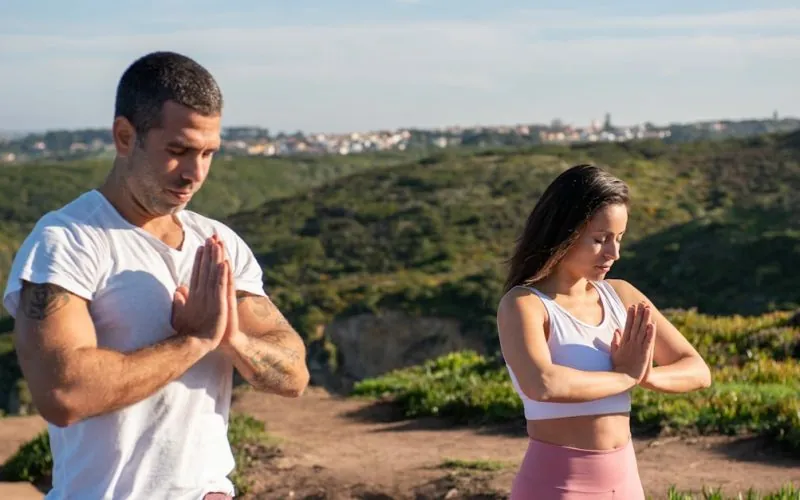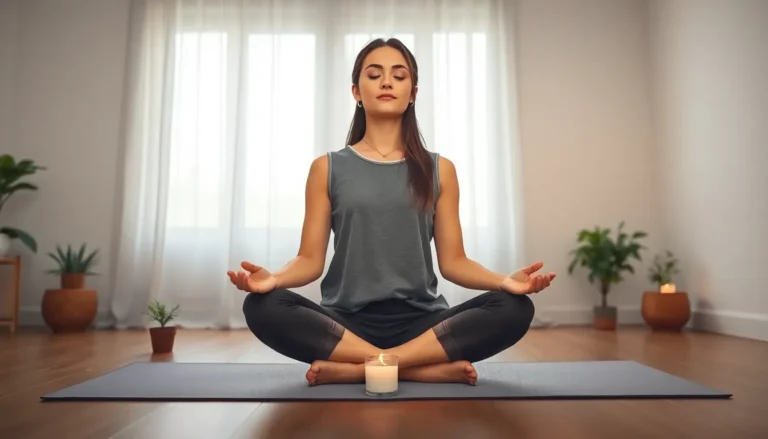Table of Contents
ToggleIn today’s fast-paced world, finding a moment of peace can feel like searching for a unicorn in a haystack. Adults are juggling work, family, and endless to-do lists, leaving little room for relaxation. Enter mindfulness activities, the secret sauce for reclaiming sanity and boosting well-being. Who knew that taking a breather could be so powerful?
Overview of Mindfulness Activities
Mindfulness activities offer adults practical methods to cultivate awareness and reduce stress. Common practices include meditation, deep breathing exercises, and mindful walking. Each activity encourages individuals to focus on the present moment rather than past or future concerns.
Meditation can vary in length and technique. Short sessions, even lasting five minutes, help build concentration skills. Longer sessions deepen relaxation and provide greater insight into thoughts and feelings. Deep breathing exercises enhance physical relaxation and calm the mind by emphasizing slow, controlled breaths.
Mindful walking involves paying attention to each step and the sensations associated with movement. It can occur outdoors, allowing individuals to connect with nature. Finding a quiet space works well for indoor practice, promoting mindfulness in a controlled environment.
Journaling serves as another effective mindfulness activity. Writing thoughts and emotions fosters self-reflection and emotional processing. Various prompts can guide journaling practices, such as expressing gratitude or reflecting on personal experiences.
Mindfulness yoga combines physical movement with breathing awareness. It improves flexibility and promotes a sense of inner peace. Simple poses can be practiced at any skill level, making it accessible for everyone.
Finally, engaging in creative activities, like drawing or painting, helps tap into a state of mindfulness. These activities provide a unique outlet for self-expression and relaxation. Trying out different mindfulness activities can lead to understanding personal preferences and benefits.
Benefits of Mindfulness for Adults
Mindfulness offers numerous advantages for adults, directly enhancing their overall well-being and quality of life. Engaging in mindfulness activities leads to various mental and physical benefits.
Mental Health Improvements
Mindfulness practices significantly boost mental health by reducing symptoms of anxiety and depression. Studies indicate that regular meditation fosters emotional regulation and resilience. Individuals often report increased clarity of thought and improved focus after practicing mindfulness regularly. Stress levels decrease as these activities allow individuals to step back from overwhelming thoughts. Enhanced self-awareness arises, helping participants recognize and manage their emotions better. Research shows that mindfulness can lead to more balanced perspectives, enabling a greater ability to cope with daily challenges.
Physical Health Benefits
Physical health outcomes improve substantially through mindfulness techniques. Heart rates often lower during deep breathing exercises, promoting cardiovascular health. Regular participation in mindfulness yoga also contributes to improved flexibility and muscle tone. Research indicates that consistent mindfulness practice can lead to better immune function, reducing illness frequency. Sleep quality enhances as mindful activities encourage relaxation and decreased stress levels. While these activities vary, each contributes to a holistic improvement in physical well-being for adults.
Types of Mindfulness Activities
Mindfulness activities can vary greatly, catering to different preferences and lifestyles. Below are some prominent types of mindfulness practices that adults can incorporate into their daily routines.
Breathing Exercises
Breathing exercises encourage individuals to focus on their breath, cultivating awareness of the present moment. Techniques like diaphragmatic breathing involve inhaling deeply through the nose, filling the abdomen, then exhaling slowly through the mouth. Practicing these exercises for even a few minutes can alleviate stress and promote relaxation. Individuals may find guided sessions or apps helpful for learning various techniques. Consistent practice enhances emotional regulation, making it easier to cope with everyday stressors.
Meditation Practices
Meditation practices encompass a range of techniques aimed at cultivating mental clarity and emotional stability. Individuals can explore mindfulness meditation, focusing on breath or body sensations, or loving-kindness meditation, which promotes compassion towards oneself and others. Start with short sessions and gradually increase the duration to build endurance. During meditation, distractions may arise; acknowledging them without judgment is part of the process. Regular engagement in meditation contributes to improved focus and reduced anxiety.
Guided Imagery
Guided imagery involves visualizing peaceful scenes or scenarios, allowing individuals to escape from daily stressors. Participants typically follow audio recordings or scripts leading them through detailed mental landscapes. Imagining a serene beach or a tranquil forest can enhance relaxation and foster a sense of inner peace. This practice encourages creativity while reducing anxiety and instilling calmness. Utilization of guided imagery techniques can significantly improve overall well-being when practiced regularly.
Journaling Techniques
Journaling techniques provide a structured way to process thoughts and emotions. Different methods such as gratitude journaling, stream-of-consciousness writing, or reflective prompts encourage individuals to explore their feelings. By writing down experiences, a person gains clarity and insight into personal challenges. Even dedicating just a few minutes each day to journaling can yield substantial benefits. The act of writing fosters self-awareness, helping individuals articulate emotions and track progress over time.
How to Access Mindfulness Activities for Adults PDF
Accessing mindfulness activities for adults often involves downloading PDFs that provide structured practices. Many websites offer free resources that can be easily accessed by anyone interested in enhancing their mindfulness journey.
Downloading Resources
Downloading resources is straightforward. Users typically find PDF links on dedicated mindfulness websites. Clicking on the download button saves the file directly to their device, allowing for easy offline access. Ensure to check that the resource aligns with specific mindfulness goals, whether focusing on meditation, journaling, or breathing exercises. Many sites require no registration, making it simple for individuals to begin their mindfulness practice immediately.
Recommended Websites
Several reputable websites provide high-quality mindfulness PDFs. Mindful.org offers a variety of resources tailored for adults. The Greater Good Science Center presents evidence-based practices that enhance well-being. Additionally, the American Psychological Association website features activities that support emotional health. Each of these platforms maintains user-friendly interfaces, ensuring easy navigation to find and download valuable mindfulness materials.
Tips for Practicing Mindfulness
Engaging in mindfulness can enhance overall well-being. Start by designating a specific time each day for mindfulness practices. Choose a quiet spot free from distractions to encourage focus. Explore various techniques, such as meditation and deep breathing exercises, to find what resonates. Experimenting with mindfulness yoga can integrate movement and breath, creating a more immersive experience.
Incorporate journaling into your routine to cultivate self-reflection. Using gratitude journaling prompts helps shift attention to positive aspects of life. Reflect on emotions regularly to foster a deeper understanding of oneself. Practice mindful walking to connect with nature and ground yourself in the present moment. Observing surroundings during walks increases awareness and appreciation.
Utilizing guided imagery during mindfulness sessions can create calming visuals. Visualizing serene scenes promotes relaxation and reduces anxiety. Joining mindfulness groups or online communities can provide motivation and support. Sharing experiences with others enhances accountability and encourages habit formation.
Track progress in a dedicated mindfulness journal to visualize improvements over time. Recording feelings and experiences enhances self-awareness and supports emotional regulation. Committing to regular practice cultivates lasting benefits, making mindfulness a valuable addition to daily life.
Accessing mindfulness resources can ease the journey. Downloading PDFs from reputable sources ensures access to structured activities. Sites like Mindful.org and the Greater Good Science Center provide valuable tools for adults seeking to deepen their mindfulness practice. Prioritizing consistency and exploration leads to better mental clarity and emotional stability.
Embracing mindfulness activities can transform an adult’s daily life by fostering peace and enhancing overall well-being. By integrating practices like meditation deep breathing and mindful walking into their routines individuals can experience significant improvements in mental clarity and emotional stability. The accessibility of resources such as downloadable PDFs makes it easier to explore various techniques and find what resonates personally.
With consistent practice adults can navigate their busy lives with greater ease and resilience. Mindfulness isn’t just a trend; it’s a powerful tool for reclaiming balance and nurturing a healthier mindset. By prioritizing these activities individuals can unlock the profound benefits of mindfulness and create a more fulfilling life.




